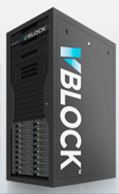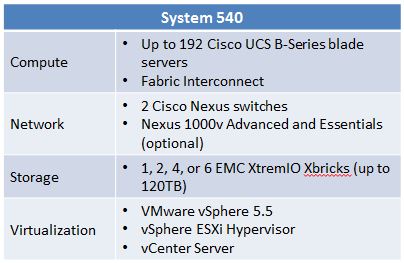 Today, in their largest announcement since EMC, Cisco, and VMware jointly announced the company’s formation five years ago, VCE announced seven new additions to their product lineup. These new additions consist of:
Today, in their largest announcement since EMC, Cisco, and VMware jointly announced the company’s formation five years ago, VCE announced seven new additions to their product lineup. These new additions consist of:
- 3 new Vblock models (System 240, 540, and 740)
- 2 new “technology extensions” (Storage (Isilon) and Compute (Cisco UCS))
- 2 integrated solutions for cloud management (Cisco and VMware)
I’ll walk through each of these in more detail below.
New Models
As part of today’s announcement, VCE unveiled three new Vblock models. Two of them (System 240 and 740) will replace older models in the lineup, while one (System 540) is a brand-new expansion of the VCE offerings.
The new lineup of Vblocks can be seen below.
Vblock System 240
First up is the System 240 which uses the EMC VNX 5200 for storage. This Vblock replaces the System 200, which used the VNX 5300.
The VNX 5200 is a smaller model array than any of those used in the System 340 (any of the VNX 5400, 5600, 5800, 7800, or 8000). It’s worth noting that the System 340 accounts for approximately 75% of all Vblocks currently being shipped. I believe the System 240 is intended to expand market share in the “workloads that fit the VNX” area.
VCE sees the System 240 as being a good fit for:
- E-discovery and compliance
- Isolated workloads in large enterprises
- Mixed workloads in mid-sized data centers
Details on the System 240 are below.
Vblock System 540
The System 540 is a new addition to the Vblock line, rather than a replacement for an older model.
The System 540 uses the EMC XtremIO for its storage. As such, VCE is billing it as the world’s first all-Flash converged infrastructure.
(Folks knowledgeable about the “Vblock Specialized Systems” may question this. It’s true that the Vblock Specialized System for Extreme Applications uses XtremIO, but it also uses the EMC VNXe 3150, so it isn’t all-Flash. The Vblock Specialized System for High-Performance Databases uses Flash in EMC VNX, but the array’s vault drives are not Flash.)
VCE sees the System 540 as being a good fit for:
- Mixed high-performance database workloads
- End-user Computing, when used with either the Technology Extension for Storage or for Compute
- Virtualization of mixed workloads
Details on the System 540 are below:
Vblock System 740
The last of the new models is the System 740 which uses the EMC VMAX3 (100K, 200K, or 400K) for storage. This Vblock replaces the System 720, which uses the VMAX2 (10K, 20K, or 40K). VCE says the 740 offers up to three times the storage performance and twice the storage bandwidth of the 720.
VCE believes that the System 740 will be the model of choice for existing VMAX customers who are considering converged infrastructure.
VCE sees the System 740 as being a good fit for:
- Mixed high-performance workloads
- Mission-critical applications (e.g.: Microsoft, Oracle, SAP)
- High-performance databases (e.g.: SQL, Oracle)
Vblock Technology Extensions
VCE views the Technology Extensions as separate products. It’s probably easiest to think of them as specialized product bundles.
Vblock has a very firm definition of what is (and isn’t) supported in its configurations. You can’t easily scale storage and compute independently of each other — or you couldn’t before the Technology Extensions.
Technology Extension for Storage (Isilon)
EMC Isilon has been being sold alongside or bundled with Vblock for a while now, but there’s always been a clear separation between the two. Virtual machines run on storage in the Vblock, not on the Isilon, and the Isilon cluster is used for additional storage, for example, VDI with the desktop images being served by the Vblock while users’ home directories are served by the Isilon.
The VCE Technology Extension for Storage starts to blur the separation a little. In this offering, the Isilon cluster can be managed from the same interface used to manage the Vblock. Similarly, support for the Isilon is provided by the same centralized support as the Vblock.
With the release of this Technology Extension, VCE now supports adding an Isilon cluster to an existing Vblock deployment.
Vblock with the Storage Technology Extension can be used for:
- End-user computing (VDI)
- Analytics clusters
- Media and Entertainment
- Financial transaction processing and archiving
- Medical transaction and image processing
- Seismic processing for oil and gas
Technology Extensions for Compute (Cisco UCS)
Vblock has always used Cisco UCS blade servers, so, on the surface, this might not appear to be anything new. This technology extension allows customers to add additional Cisco UCS rackmount servers to a Vblock.
This gives customers the ability to scale the compute power of a Vblock higher than was possible before. It also opens the door to expanded capabilities as the rackmount servers are able to support PCIe cards that won’t fit in blade servers, enabling functions like graphics processing (by adding graphics cards) and high-speed transaction processing (by increasing the memory footprint).
This technology extension also gives customers flexibility to mix blade servers and rackmount servers. It also enables Vblock to now work with applications that have proprietary requirements (for example, Meditech).
Vblock with the Compute Technology Extension can be used for:
- Mixed workloads
- Animation and video processing
- Big data processing
Integrated Solutions for Cloud Management
VCE has always positioned Vblock as a building block for Cloud, although in practice its use has been pretty much exclusively for private cloud.
The Integrated Solutions for Cloud Management offer options for starting to use Vblock as part of a hybrid cloud solution. VCE is offering two editions of this integrated solution.
Cloud Management Solution — Cisco Edition
With the Cisco Edition, the Vblock ships pre-integrated with Cisco UCS Director software for onsite configuration services. The Cisco Edition still uses the VCE Vision software for converged infrastructure management.
Cloud Management Solution — VMware Edition
With the VMware Edition, the Vblock ships pre-integrated with multiple management software options:
- VMware vRealize Suite
- VCE Vision integrated with vCenter Server and vCenter Operations
- EMC ViPR for storage provisioning
“Cabinet 2.0”
Given all of the other information associated with today’s announcements, it might be possible to overlook some other new features that VCE is rolling out.
The System 540 and 740 Vblock models both ship in new racks that VCE is calling “Cabinet 2.0”. These new racks include advanced power management features and environmental sensors. The new cabinets offer customers more options for remote management and “lights-out” data centers.
Availability
The Vblock System 240 is shipping now.
The Vblock System 540 and 740 can be ordered now and will begin shipping in December.



